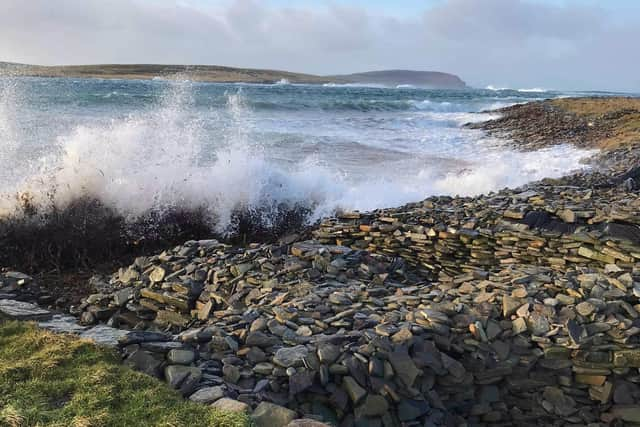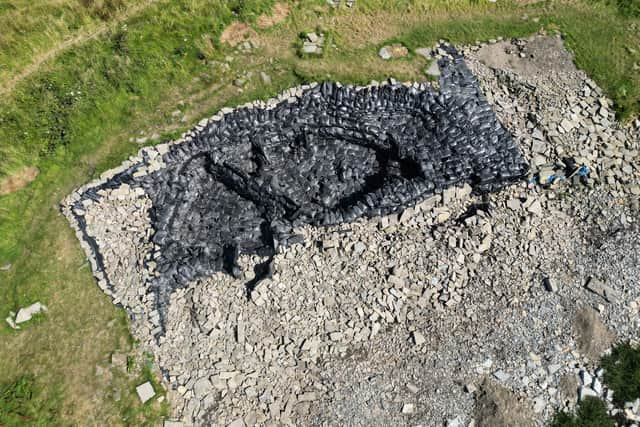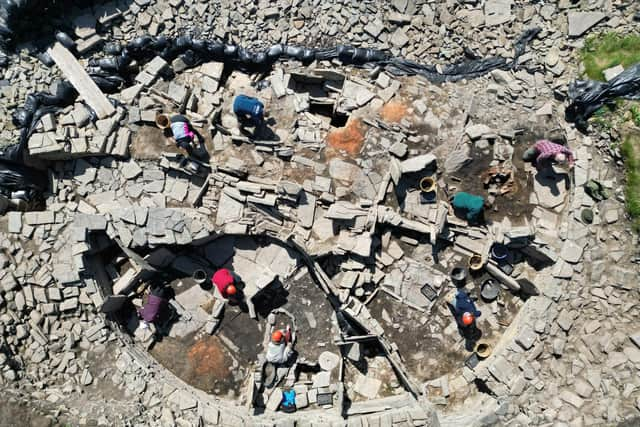'Viking demolition' of Pictish-era settlement in Orkney uncovered
Summer excavations at an island dubbed the “Egypt of the North” have revealed the deliberate demolition of a Pictish-era roundhouse and settlement and a takeover by Viking arrivals.Around 18 archaeologists have spent three months at Swandro Bay on the Orkney island of Rousay this summer with the team making an apparent breakthrough in the timeline of the site where a giant broch-style roundhouse, likely inhabited by an island elite, towered over surrounding homes and workshops.
It comes as archaeologists work against erosion of the site due to rising tides and the impact of global warming, with half the roundhouse now having slipped into the sea and seawater encroaching on the remains.
Advertisement
Hide AdAdvertisement
Hide AdDr Stephen Dockrill, reader in archaeology and teaching fellow at Bradford University, has spent almost 30 years researching the site with Dr Julie Bond and colleagues with Swandro Bay helping to unlock understanding of the key period when the Pictish era gave way to the Viking age.


He said it had been an “exciting “ season with remains of furnaces found in the roundhouse and evidence of iron smelting and the manufacture of knives with deer antlers also discovered.
Crucially, demolition of the roundhouse – which was taken down in a “deliberate event” – was detected with Viking-period artefacts left behind in the top layer of remains.Dr Dockrill said: “The broch was purposely demolished and indications suggest this may have occurred during a takeover of Scandinavian people. My personal opinion, based on what was happening at other sites, is that the settlement was occupied at the time of the demolition.
He added: “What we can see at the roundhouse is a big collapse event, walls are toppled and it looks to be a very rapid event. It is not the house falling down over time.
"There seems to be a huge collapse event with whole walls going and stone tumbling down at angles, it looks as if there was a deliberate event that demolishes the building.”


He said there was no evidence of abandonment deposits, which are found when a site is vacated at the end of its life, with it appearing as if the settlement was still standing and, to some extent, in use at the time it was toppled.
Stone from the roundhouse appears to have then been used to lay a path to part of a Viking longhouse which was built around 20 metres away on the site of an Iron Age smiddy.
The remains of the settlement at Swandro Bay have been excavated over the summer since the mid-1980s with archaeologists known to take unpaid annual leave from their day jobs to take part in the digs given the “special nature” of archaeology.
Advertisement
Hide AdAdvertisement
Hide AdThe earliest date of human use of the site dates to 800 to 500 BC with the roundhouse likely inhabited from around the 1st Century AD and into the Pictish era, with dates so far mapping activity during this period from the 4th to the 7th Centuries AD.


A number of items found in the top layer remains of the roundhouse date to the 9th Century, including a Scandinavian-style needle case and coin of Eanred, the King of Northumbria in the first half of the century.
Rousay earned the name “Egypt of the North” in the 1930s due to its rich archaeology, with more than 160 sites recorded including Midhowe Broch and Midhowe Chambered Cairn, both of which overlook the Eynhallow Sound. The stretch of water separates Rousay from mainland Orkney, where the Broch of Gurness looks back over to Swandro Bay.
Dr Dockrill said the stretch of water was akin to the “motorway” of the day and served as a main route into Orkney and back out to the North Atlantic. The land that flanked the sound would have been richly fertile and coveted by the Scandinavian arrivals, he added.
As Dr Dockrill and his team depart Rousay for another year, more than 1,500 sandbags and a membrane have been used to secure the site in a bid to protect it from rising water levels and winter storms.
Dr Dockrill said: “The sea is encroaching onto the site - anything there is in danger. The bottom half of the roundhouse has been lost to the sea.
"We are seeing every tide that comes in sucks out archaeological sentiment.
“There is a water table from the water running from the high points of the island which drains through the soil and the rock.
Advertisement
Hide AdAdvertisement
Hide Ad“When the sea comes in all the very finest silts go into suspension and when the tide draws out again it pulls out those very very fine particles underneath.
"You can be excavating through layers of archaeology and suddenly find you come onto beach sand and within that sand you are sometimes finding bits of plastic.”
He added the work of the Swando team was stopping the story of the site being “lost forever”.
Dr Dockrill said: "It is eroding away but if we weren’t doing what we are doing, all that information would be lost forever. What we are doing in effect is rescue archaeology with a very strong research agenda. We are trying to find out as much as we can.
“We are far better digging a site like that than going into a site that would be quite happy sitting the ground for generations. It is a golden opportunity to learn a bit more about the past and being able to save something for future generations in terms of knowledge.”
Comments
Want to join the conversation? Please or to comment on this article.